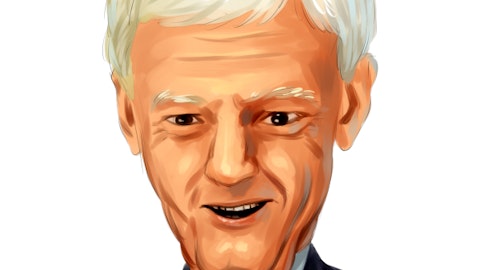Rob Dillard: Yes Adam, it’s obviously an incredible focus of the business to develop the right strategies and really invest behind them, and you saw that with the flexible business, which had mid single digit growth throughout last year, even in December with the difficult market conditions that everybody saw. But we’ve done this–we’ve got new leadership in the global can business and a really unified strategy. I’d say most of the regions in the world are growing high single digits and Asia is growing double digits in paper cans, and we’re really excited about bringing innovation to that segment and enabling our customers to launch new products there. Plastics is another area that really we’ve invested behind and they’ve started to really grow, so each one of those businesses has mid single digit growth prospects and we’re anticipating that that will come through this year.
Adam Josephson: Wow, okay. Just to be clear, for the total company, Rob, what is–roughly what is your volume expectation for the year? I assume you’re assuming up something, even with industrial being down.
Rob Dillard: Yes, up 1% to 2%.
Adam Josephson: One to two – okay. One other clarification, Rob – on the working capital, you said that you’re expecting a meaningful benefit. Can you be any more specific than that?
Rob Dillard: Well, I think that we’re targeting at least $100 million of improvement, and mainly through inventory management.
Adam Josephson: Got it – lower inventories, okay. Howard, you expressed, I think, some frustration about some of the questions you’re getting, and I guess from our seat, most–well, really all paper-based packagers had historic price cost benefits last year, for reasons you’re well aware of, and many experienced historic margin expansion, as did you, so it’s hard for us just on the outside to parse out the rising tide lifting all boats versus these company-specific operational initiatives that you have. Is there any help, more help you can give us in terms of parsing those two out, and understanding how you’re thinking that will shake out this year and thereafter, for that matter?
Howard Coker: Yes, first Adam, I deeply apologize if you felt like I was frustrated. I look forward to these calls like you have no idea each quarter and having subsequent meetings within the quarter. But it does become frustrating when–and I’m sorry again, yes, the dissertation, as you may say, but–. You know, again, going back not too many years ago, 50% of this company was a paper industrial company. It’s now in the 30%, 35% range, and that is a tale in and of itself. I can’t answer your question specifically other to say that if there is a frustration, the peanut butter spread of your paper company is a paper company is a paper company, it’s trying to give you guys a little bit more color in terms of how we’re looking at our segment within the paper industry and how we’re doing things to take away as much of the volatility that we historically have had through those self-help actions that I described.
All inclusive, as I said, we’re expecting to see price moderation, we’re expecting to see cost inflation as OCC cannot stay where it is forever, but we’ve taken actions over many years to reduce our exposure, be it from ultimate price to controlling productivity, etc. I’m backing down a bit, Adam, so–.
Adam Josephson: No, I just–no, it’s helpful to hear you, because again, it really is hard for us to know how much of a rising tide lifting all boats situation this is, because we just–we obviously don’t have the visibility that you do. Just a last thing, Rob, just back to the volume for one moment, if you don’t mind. Compared to the 1% to 2% up for the year, what are your expectations for the first quarter? I’m trying to understand how back half weighted that expected volume growth is.
Rob Dillard: Yes, that’s a good question. Quarter to quarter, I’d say consumer volume growth is coming through now on a year-over-year basis and sequentially. For industrial, we’re kind of–we’re probably going to be flat sequentially with some back end improvement, and we’ve modeled in our core–our base scenario for that business is that we’re going to see kind of a flat recession or a soft landing and then some recovery in the second half of the year, which we think is the consensus from those sources. Then the other businesses are expected to–and we’re seeing kind of a good start to the year that will flow through both–through the full year.
Adam Josephson: Thanks very much.
Howard Coker: Thanks Adam.
Operator: Thank you. Our next question comes from the line of Ghansham Panjabi with Baird. Your line is now open.
Matt Krueger: Hi everybody, this is Matt Krueger sitting in for Ghansham. Thanks for taking my questions. You know, you highlighted customer inventory destocking on the consumer side of the business late into the fourth quarter, but it doesn’t sound like there’s any expectation for lingering impact or carryover in the first quarter. Are you seeing real time improvement here already, and it seems like a quick inventory destock cycle, can you just talk through some of the dynamics that you’ve seen in that business and why the confidence on such a quick improvement in the first quarter here?





